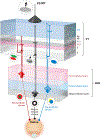Role of Feedback Connections in Central Visual Processing
- PMID: 32552571
- PMCID: PMC9990137
- DOI: 10.1146/annurev-vision-121219-081716
Role of Feedback Connections in Central Visual Processing
Abstract
The physiological response properties of neurons in the visual system are inherited mainly from feedforward inputs. Interestingly, feedback inputs often outnumber feedforward inputs. Although they are numerous, feedback connections are weaker, slower, and considered to be modulatory, in contrast to fast, high-efficacy feedforward connections. Accordingly, the functional role of feedback in visual processing has remained a fundamental mystery in vision science. At the core of this mystery are questions about whether feedback circuits regulate spatial receptive field properties versus temporal responses among target neurons, or whether feedback serves a more global role in arousal or attention. These proposed functions are not mutually exclusive, and there is compelling evidence to support multiple functional roles for feedback. In this review, the role of feedback in vision will be explored mainly from the perspective of corticothalamic feedback. Further generalized principles of feedback applicable to corticocortical connections will also be considered.
Keywords: corticocortical; corticogeniculate; corticothalamic; feedback; spatial receptive field properties; temporal receptive field properties.
Figures

Similar articles
-
Feedforward, horizontal, and feedback processing in the visual cortex.Curr Opin Neurobiol. 1998 Aug;8(4):529-35. doi: 10.1016/s0959-4388(98)80042-1. Curr Opin Neurobiol. 1998. PMID: 9751656 Review.
-
Feedback generates a second receptive field in neurons of the visual cortex.Nature. 2020 Jun;582(7813):545-549. doi: 10.1038/s41586-020-2319-4. Epub 2020 May 20. Nature. 2020. PMID: 32499655 Free PMC article.
-
Circuits and Mechanisms for Surround Modulation in Visual Cortex.Annu Rev Neurosci. 2017 Jul 25;40:425-451. doi: 10.1146/annurev-neuro-072116-031418. Epub 2017 May 3. Annu Rev Neurosci. 2017. PMID: 28471714 Free PMC article. Review.
-
Towards a Unified View on Pathways and Functions of Neural Recurrent Processing.Trends Neurosci. 2019 Sep;42(9):589-603. doi: 10.1016/j.tins.2019.07.005. Epub 2019 Aug 6. Trends Neurosci. 2019. PMID: 31399289 Review.
-
Cortical feedback signals generalise across different spatial frequencies of feedforward inputs.Neuroimage. 2018 Oct 15;180(Pt A):280-290. doi: 10.1016/j.neuroimage.2017.09.047. Epub 2017 Sep 22. Neuroimage. 2018. PMID: 28951158
Cited by
-
Sub-bundle based analysis reveals the role of human optic radiation in visual working memory.Hum Brain Mapp. 2024 Aug 1;45(11):e26800. doi: 10.1002/hbm.26800. Hum Brain Mapp. 2024. PMID: 39093044 Free PMC article.
-
Flicker light stimulation induces thalamocortical hyperconnectivity with LGN and higher-order thalamic nuclei.Imaging Neurosci (Camb). 2023 Nov 23;1:imag-1-00033. doi: 10.1162/imag_a_00033. eCollection 2023. Imaging Neurosci (Camb). 2023. PMID: 40799697 Free PMC article.
-
Morphological evidence for multiple distinct channels of corticogeniculate feedback originating in mid-level extrastriate visual areas of the ferret.Brain Struct Funct. 2021 Dec;226(9):2777-2791. doi: 10.1007/s00429-021-02385-7. Epub 2021 Oct 12. Brain Struct Funct. 2021. PMID: 34636984 Free PMC article.
-
Mesoscale functional organization and connectivity of color, disparity, and naturalistic texture in human second visual area.Elife. 2025 Mar 20;13:RP93171. doi: 10.7554/eLife.93171. Elife. 2025. PMID: 40111254 Free PMC article.
-
Cortical-subcortical interactions in goal-directed behavior.Physiol Rev. 2023 Jan 1;103(1):347-389. doi: 10.1152/physrev.00048.2021. Epub 2022 Jun 30. Physiol Rev. 2023. PMID: 35771984 Free PMC article. Review.
References
LITERATURE CITED
-
- Alexander GM, Godwin DW. 2005. Presynaptic inhibition of corticothalamic feedback by metabotropic glutamate receptors. J. Neurophysiol 94:163–75 - PubMed
-
- Alonso J-M, Usrey WM, Reid RC. 1996. Precisely correlated firing in cells of the lateral geniculate nucleus. Nature 383:815–19 - PubMed
-
- Anderson JC, Da Costa NM, Martin KAC. 2009. The W cell pathway to cat primary visual cortex. J. Comp. Neurol 516:20–35 - PubMed
RELATED RESOURCES
-
- Briggs F, Usrey WM. 2013. Functional properties of cortical feedback to the primate lateral geniculate nucleus. In The New Visual Neurosciences, ed. Werner JS, Chalupa LM, pp. 315–22. Cambridge, MA: MIT Press
Publication types
MeSH terms
Grants and funding
LinkOut - more resources
Full Text Sources

